Electrode apparatus for preventing cracking of the electrode and insulating layers
a biocompatible electrode and electrode technology, applied in the field of electrode apparatus for preventing cracking of the electrode and the insulating layer, can solve problems such as leakage of electricity, and achieve the effects of convenient control of thickness, convenient elongation, and correct drawing
- Summary
- Abstract
- Description
- Claims
- Application Information
AI Technical Summary
Benefits of technology
Problems solved by technology
Method used
Image
Examples
second experimental example
[0022]In order to more firmly make sure of the result of the first experimental test, the same experiment as in the first experimental example using polyester-series resin (merchandise name: ELITEL UE-3223, manufactured by Unitika K. K.) having a glass transition temperature of 1 degree C. as a low Tg resin, and further using the same polyester-series resin (merchandise name: ELITEL UE-9800, manufactured by Unitika K. K.) having a glass transition temperature of 85 degrees C. as in the first experimental example as a high Tg resin. Table 2 shows the result of the second experimental example.
[0023]
TABLE 2Con-Con-TgTgjugatejugateFine85 de-1 de-AngleAngleBlock-crack-grees C.gree C.230° C.250°ingingSample 8 100 parts 0 parts10 / 10 10 / 10 NoXSample 9 80 parts20 parts10 / 10 10 / 10 NoXSample 1060 parts40 parts0 / 100 / 10NoΔSample 1150 parts50 parts0 / 100 / 10No◯Sample 1240 parts60 parts0 / 100 / 10Yes◯Sample 1320 parts80 parts0 / 100 / 10Yes◯Sample 14 0 parts100 parts 0 / 100 / 10Yes◯(Occurrence number of crac...
third experimental example
[0025]So, investigation was further continued as to what kind of adverse effects are prevailed on cracking or blocking of the electrically insulating layer 30 by changing the glass transition temperature. The results are shown in Tables 3 and 4.
[0026]
TABLE 3ConjugateConjugateResin TgAngle 230°Angle 250°BlockingSample 15Tg 85 degrees C.6 / 1010 / 10NoSample 16Tg 67 degrees C.4 / 1010 / 10No
[0027]
TABLE 4Low Tg resin−29−201High Tg resin40XX◯67ΔΔ◯85◯◯◯◯: No blocking has occurredΔ: Blocking has slightly occurredX: Blocking has occurred
[0028]From the result of Table 3 regarding the resins having the glass transition temperatures of 85 degrees C. and 67 degrees C., it is known that the two resins are effective in preventing the occurrence of blocking but the resin having the lower glass transition temperature of 67 degrees C. than the resin having the higher glass transition temperature of 85 degrees C. seems to be more effective for the purpose of prevention of the occurrence of cracking of the e...
PUM
 Login to View More
Login to View More Abstract
Description
Claims
Application Information
 Login to View More
Login to View More - R&D
- Intellectual Property
- Life Sciences
- Materials
- Tech Scout
- Unparalleled Data Quality
- Higher Quality Content
- 60% Fewer Hallucinations
Browse by: Latest US Patents, China's latest patents, Technical Efficacy Thesaurus, Application Domain, Technology Topic, Popular Technical Reports.
© 2025 PatSnap. All rights reserved.Legal|Privacy policy|Modern Slavery Act Transparency Statement|Sitemap|About US| Contact US: help@patsnap.com



